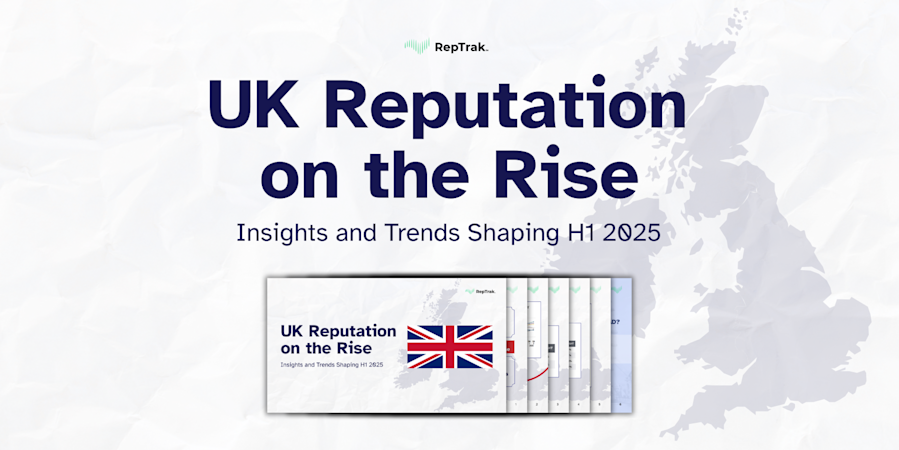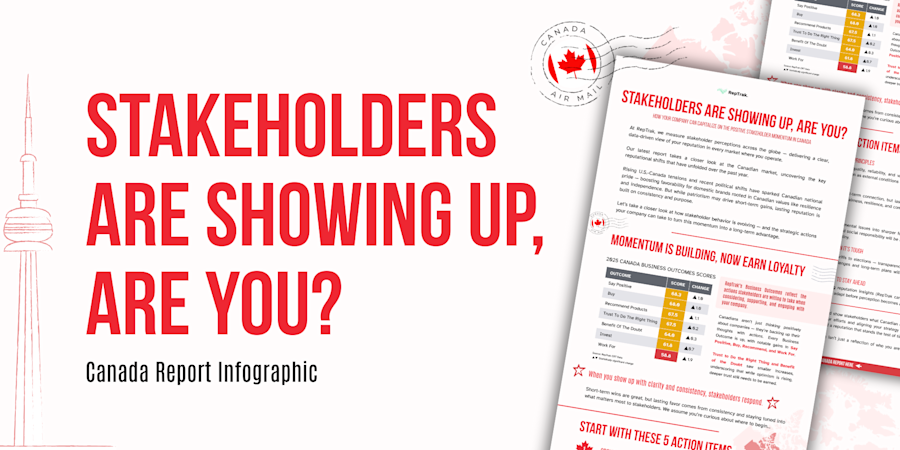7 Things to Avoid When Measuring Corporate Reputation
Blog Post19 Aug, 2019
The seminal book on reputation is Reputation: Realizing Value from the Corporate Image, by Dr. Charles Fombrun, founder of The RepTrak Company. The book, published in 1996 and re-released as a 20th aniversary edition, delineates the fundaments of what presently is known as the theory of corporate reputation management.
Despite the revolutionary insights that this dissertation provided the field of reputation with, there have been notable advancements since then. The understandable skepticism that arose with regard to measuring a variable as ephemeral as reputation no longer exists. It was debunked by the development of measurement systems such as the Reputation Quotient (1999), and the more developed RepTrak®, first launched in 2005, and now considered to be the worldwide de facto standard for reputation tracking.
Measuring an Intangible Concept
With time, progress has led to many triumphs in the enrichment and professionalisation of the management of intangibles. These primarily include:
The integration of reputation metrics among different business and financial metrics to establish an appreciable representation of the economic impact of reputation (exploring the extent of what we call the reputation economy);
The identification, calculation, and administration of reputation risks (events that could drastically impact the reputation of a company, and, thus, its finance);
The relationship between corporate reputation and brand or culture, and the integrated management of such;
The development and communication of comprehensive models of a company's sustainability, and;
The elaboration of systems for the measuring and analyzing of public discussions that could impinge on the reputation of a company
"If you can't measure it; you can't manage it"
To quote many management gurus, "If you can't measure it; you can't manage it." Despite the progress made, one can still find significant errors in the way many companies measure reputation both in matters of conceptualisation, as well as in the methodology used.
Below, I have listed the common faux pas made when measuring reputation that I consider to be the most critical.
1. Mistaking perception and reality
The first error in the tracking of corporate reputation stems from mistaking the term reputation. Merriam-Webster Dictionary defines reputation as the "overall quality or character as seen or judged by people in general; a place in public esteem or regard.”
When approaching this idea, one approaches the world of perception, evaluation, and judgement. Reputation is a perception. It is an emotional concept that encompasses the feelings of an audience.
Humans react to people, companies, or things based on how they perceive them (perception), which is not necessarily always in line with what they are actually like (reality).
Therefore, it is critical to manage reputation. The reputation of a company lives in the minds of its various stakeholders, not in the company itself. It consists of perceptions that originate from the behaviour of the company, what it communicates, and what other people and sources say about it.
Perception and reality are separate factors; a company can have a reputation (perception) which does not reflect the genuine state of things (reality), and this can either translate into an opportunity for communication (if the reality is better than the perception), or a reputation risk (if the perception is better than the reality).
Tracking reputation consists of measuring the perceptions of a company's stakeholders. This is done through different techniques of market research. A grave but common error that is often seen in certain studies is mixing variables that pertain to a company's reality and the public's perception of it, and then confusing a company's successful performance in certain areas of management with an alleged "good reputation.” Undoubtedly, successful performance in management leads to obtaining a good reputation, but reputation management is precisely about understanding the gaps between the company's reality and its perception. Thus, they are to be measured independently.
The worst scenarios of this, in my experience, are known as "verifications" of variables of an objective reality, or "expert" authentications that a certain perception is, in fact, based on a "reality".
These types of endeavours only serve to besmirch the results of an investigation by introducing an element of subjectivity into the measuring, and, thus, they stray from the true meaning of the outcome, which is and should only be, a portrayal of the opinions of a company's stakeholders and the way in which those opinions affect their attitudes and behaviours towards the company.
2. Mixing stakeholder groups (customers, employees, investors, and regulators are different and should be treated as such)
Reputation is different depending on the stakeholder being analysed. The same company can have a bad reputation among its employees or its investors and a good one among its customers. Similarly, the importance of the variables (the variables being the various drivers and attributes of reputation) can be different between each stakeholder.
Mixing data from different stakeholders is like mixing apples and oranges: to continue with the previous example, a company with a poor reputation among its employees and its investors and a good reputation among its clients is not a company with a "medium" reputation; it is a company with a poor reputation among its employees and its investors and a good one among its customers. If one wants to understand the relationship between the variables of reputation and the desired supportive behaviours of the stakeholders (buying products from the company, investing in the company, applying for work at the company, etc.) and also utilise the variables of reputation for successful management, one must approach each stakeholder individually.
3. Limited stakeholder analysis
Each stakeholder regards a company in its entirety, taking into account all of its drivers, although perhaps considering some of them to have greater importance than others.
The 7 drivers of reputation are:
Products and Services
Innovation
Workplace
Governance
Citizenship
Leadership
Performance
The analysis of a stakeholder must be done, as well, to its full extent. It can be tempting to only measure the area that seemingly is most relevant for each stakeholder (for example: asking clients about product quality; asking employees about work environment; asking NGOs about social responsibility; asking owners and investors about investment quality) because it cuts the research cost. It is not recommendable to do so, as it is an error of much gravity.
If a budget does not allow for a complete analysis of all the stakeholders, then it is better to approach stakeholders successively (i.e. clients and employees this year, and key opinion leaders and investors next year) but fully, so that a complete report of each stakeholder is made.
Experience leads me to ascertain that all drivers are relevant to all stakeholders. For example, financial stability and results may be crucial for investors, but Governance and Citizenship also are significant; similarly, though Workplace may be key for employees, Leadership can have even more importance for them.
In the majority of cases, action plans to improve reputation among a certain stakeholder involve different dimensions to the ones that would have been managed with a simplistic analysis.
4. Asking the wrong types of questions
It is very important to differentiate between reputation and top of mind. A company can be unfamiliar to most but be very respected and admired by the few who do know it, or vice versa. To understand the dissimilarity between reputation and top of mind, it is crucial, when researching, to ask questions about reputation by reference and mention of a particular occurrence or company, instead of spontaneously asking clients in surveys to answer what company has a “good reputation” or a specific attribute. To put it another way, you need to use a questionnaire in which you ask the respondent to evaluate a company for every specific attribute on a scale.
For example, if you ask the general public (whether it be more or less informed) to determine which companies they consider to have the best reputation using an unprompted question, they are going to allude to the ones that they first think of, which usually coincide with ones with greater size and public presence. Studies that openly ask for the reputation of companies, and then quantify that data by measuring the number of mentions that were submitted about each, are actually measuring a top of mind for reputation, not reputation in itself.
I have developed numerous research projects in which participants from different markets and stakeholders were asked to attest to which companies had a good or a bad reputation. It was done to define which companies were most relevant in a certain market, and it was usually done before launching a reputation study to select the companies to be included on it. The results frequently show how companies with larger sizes and a seeming omnipresence have the most mentions, for both good and bad reputations, which only serves to illustrate how it is necessary to use the right methodology to avoid finding the paradox of having the same company or companies being the ones with the best and worst reputation at the same time.
Studies of the sort present results that are extremely complaisant to large and powerful corporations. To those who work in management in these companies, I urge you to be critical and unabashed instead of falling for the very humane temptation of accepting an outcome that could potentially be as false as it appears positive.
5. Lacking mathematical models that provide management levers
A proper reputation metrics system should provide a company with levers. In other words, it should allow one to understand the extent to which a certain variable affects a company's reputation for a certain stakeholder (the weight of each variable).
To do so, it is imperative that an econometric model is used to quantitatively display relationships among the various calculated variables. It should entail the use of variables that can be more or less rational (these could vary from product quality to ethics, through innovation or social investment) to explain something as emotional as reputation (which, for the purpose of questionnaires and research, can be defined as admiration, respect and trust).
A reputation metrics system should never be arbitrarily based on somebody's criteria. Certain systems of measurement exist that, to reach indicators (variables) of reputation, do not base themselves on statistical models, but rather weigh the importance of variables according to an "expert's" judgement. At the very least, I would question the results of these methodologies.
In the case of stakeholders with limited access (regulators, scientific or political opinion leaders) it is not possible in the majority of cases to perform a quantitative study, so that a qualitative analysis is forced to be done instead. These are based on thorough, in-depth interviews. In these situations, it is essential to establish a level of objectivity with respect to the qualitative evaluations of the interviewee's responses. Customarily, in order to do this, the importance of the drivers is ranked and instead of numeric results, there are high, medium, and low values. Nevertheless, the results are presented as similarly as possible to those from other stakeholders.
Only if there is a large enough number of interviews can there be a brief questionnaire section at the end to obtain a quantitative evaluation with a directional model (with less statistical relevance, but with a use that can be advantageous in management).
6. Mistaking reputation with one of its expressions
Above all, I want to clarify that I agree with the argument that claims that the so-called "online reputation" of a company does not exist. Reputation exists and is constructed in three ways: personal experience, communication, and third-party opinions. Analysing online opinions and discussions is very important but considering the result of one of the causes of a company's reputation to be the final result of an analysis should not be done.
Information flows at a vertiginous rate due to the internet and social networks. Companies can be talked about and discussed in a manner that is permanent, not only through media outlets and their online editions or through 24-hour news channels, but also through a myriad of blogs and forums, both personal and professional. The focus of these online conversations can range from aspects that may be of importance to the company to those that are negligible.
The content of online discussions about a company should not be regarded as a measurement of its reputation, but as a variable that can influence it.
Ultimately, the fact that a company is talked about, whether it be positive or negative, and the fact that those exchanges are broadcasted online, thus gaining a larger audience and feeding into itself, is, intrinsically, a circumstance to be taken into account. For the same reason that companies used to employ press clipping techniques, which were manual, to discover what was being said about a company through the media, and then the content was analysed and crossed by a series of variables, the same is to be done with social networks and online media outlets, but with the use of more potent and versatile tools. As a matter of fact, artificial intelligence is being applied to streamline the search and codification of online discussions in a way that utilises resources in an efficient manner, and, thus, is used as a complement to the systems of measurement of reputation.
Without a doubt, it is necessary to monitor and assay discussions in an online environment. They compose a part of one of the three bases from which people build their perception of a company. Similarly, it is not only indispensable to analyse online discussions that are about the company being studied, but also discussions that involve the company's competitors. Notwithstanding, one must always keep in mind when doing so that investigating expressions/conversations does not equate to or substitute measuring reputation.
7. Using reputation metrics as a tool for public relations
Reputation is analysed because it allows for the explanation of business results. For example, RepTrak® does this through the analysis of supportive behaviours on behalf of the stakeholders (buying products, investing, applying for a position, etc.). A better reputation results in an increase of supportive behaviours, and, consequently, in better financial results. It is a predictive tool.
In some situations, the communication departments of companies only use "reputation rankings to generate positive news about their company that can be capitalised through press releases.
In reality, some studies have been carried out that do not actually focus on the business of the analysed companies, but rather in the ranking. Truth be told, this can be beneficial for those who promote it with public relations, for they appeal to the egos of top executives, but the studies do not actually impact the reputation economy. Therefore, it is difficult for the variables and indicators of these studies to be successful when predicting or explaining supportive behaviours and their effects on the company's finances.
I, myself, admit not being absolutely innocent of this, for, at times, I have fallen on this temptation when publishing rankings to divulge the importance of the management of corporate reputation. My recommendation is focusing more on the scores of the indicators rather than in the position in the rankings, and then analysing the reasons for the ups and downs in those variables while comparing them with other sources of information to best conclude on a way to improve.
Fernando Prado Abuín Senior Vice President The RepTrak Company [email protected] @fpradoRI






